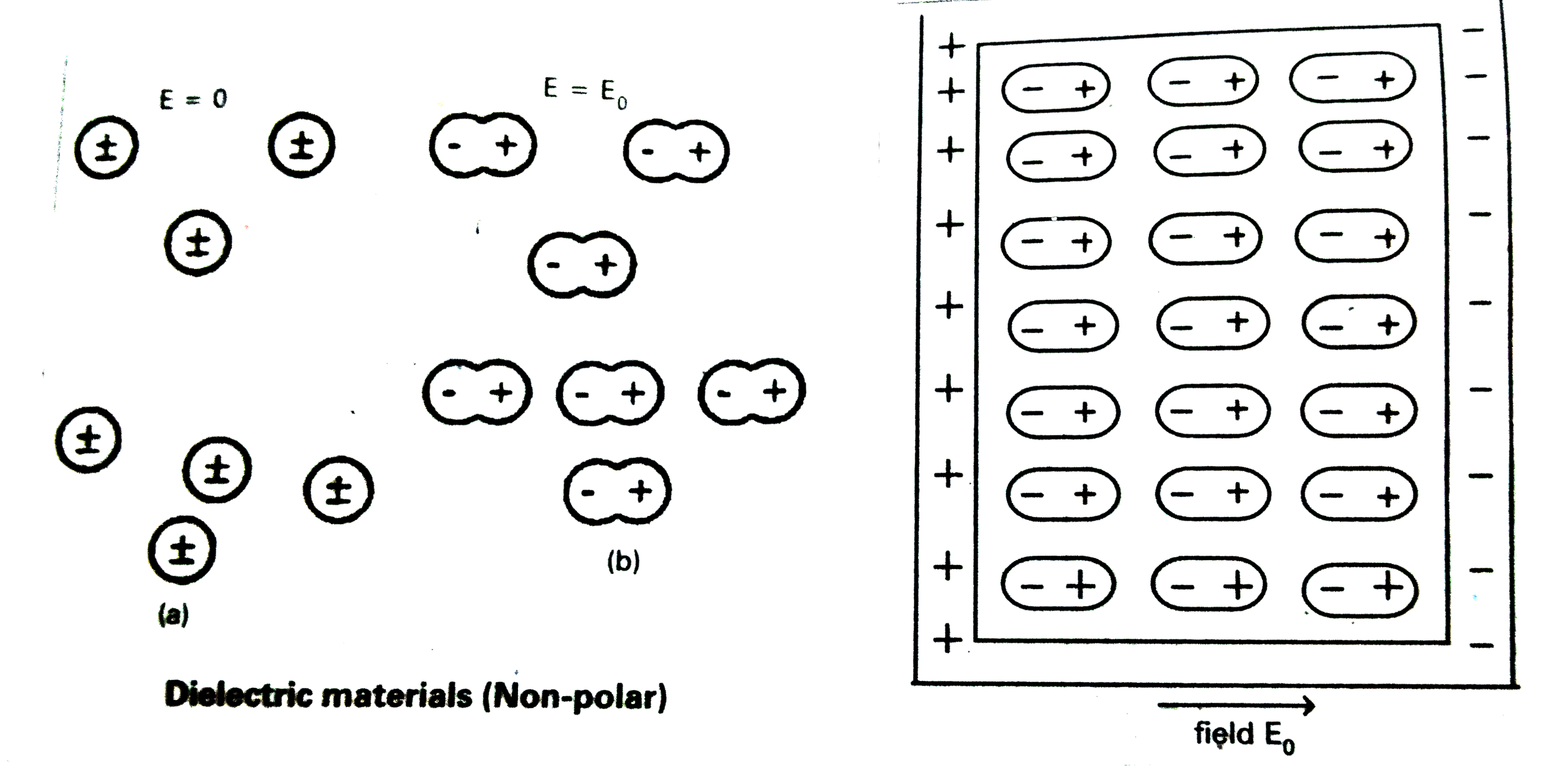Explain the behaviour of dielectrics in an external field.Solution in Telugu
1. When an external field is applied across dielectrics, the centre of positive charge distribution shifts in the direction of electric field and that of the negative charge distribution shifts.

opposite to the electric field and induce a net electric field within the medium opposite to the external field. In such situation the molecules are said to be polarised.
2. Now consider a capacitor with a dielectric between the plates. The net field in the dielectric becomes less.
3. If E0 is the external field strength and E1 is the electric field strength induced , then the net field ˆEnet=ˆE0+ˆE1
(Enet)=E0−Ei=EK where K is the dielectric constant of the medium.
Topper's Solved these Questions
- ELECTROSTATIC POTENTIAL AND CAPACITANCEBOOK - VIKRAM PUBLICATION ( ANDHRA PUBLICATION)CHAPTER - ELECTROSTATIC POTENTIAL AND CAPACITANCEEXERCISE - Long Answer Questions
3 Videos
- ELECTROSTATIC POTENTIAL AND CAPACITANCEBOOK - VIKRAM PUBLICATION ( ANDHRA PUBLICATION)CHAPTER - ELECTROSTATIC POTENTIAL AND CAPACITANCEEXERCISE - Textual Exercises
11 Videos
- ELECTROSTATIC POTENTIAL AND CAPACITANCEBOOK - VIKRAM PUBLICATION ( ANDHRA PUBLICATION)CHAPTER - ELECTROSTATIC POTENTIAL AND CAPACITANCEEXERCISE - Very Short Answer Questions
10 Videos
- ELECTROMAGNETIC WAVEBOOK - VIKRAM PUBLICATION ( ANDHRA PUBLICATION)CHAPTER - ELECTROMAGNETIC WAVEEXERCISE - ADDITIONAL EXERCISES
19 Videos
- MAGNETISM AND MATTERBOOK - VIKRAM PUBLICATION ( ANDHRA PUBLICATION)CHAPTER - MAGNETISM AND MATTEREXERCISE - Additional Exercises
19 Videos
Similar Questions
Define electric potential. Derive and expression for the electric potential due to an electric dipole and hence the electric potential at a point (a) the axial line of electric dipole (b) on the equatorial line of electric dipole.
View SolutionTwo charges 5×10−8Cand−3×10−8C are located 16 cm apart. At what point(s) on the line joining the two charges is the electric potential zero? Take the potential at infinity to be zero.
View SolutionCan there be electric potential at a point with zero electric intensity ? Give an example.
View SolutionSuppose that the electric field part of an electromagnetic wave in vacuum is E={(3.1 N/C) cos [(1.8 rad/m)y+{5.4×106 rad/s} t]} i.
What is the direction of propagation ?
View SolutionWhy does a paramagnetic sample display greater magnetisation (for the same magnetising field) when cooled?
View SolutionWith the help of neat diagrams, explain how the nonpolar dielectric material is polarised in external electric field of increasing intensity. Define polarisation in dielectrics.
View SolutionWith the help of neat diagrams, explain how the nonpolar dielectric material is polarised in external electric field of increasing intensity. Define polarisation in dielectrics.
View SolutionWith the help of neat diagrams, explain how the nonpolar dielectric material is polarised in external electric field of increasing intensity. Define polarisation in dielectrics.
View SolutionExplain the behaviour of dielectrics in an external field.
View Solutionजब किसी परावैद्युत को किसी बाह्य विद्युत क्षेत्र में रखा जाता है तो उसके अंदर विद्यत क्षेत्र कम हो जाती है, क्यों?
View SolutionDepict the behaviour of magnetic field lines when (i) diamagnetic and (ii) a paramagnetic material is placed in an external magnetic field. Mention briefly the properties of these materials which explain this distinguishing behaviour.
View SolutionExplain dielectrics in detail and how an electric field is induced inside a dielectric .
View SolutionExplain , using suitable diagrams , the difference in the behaviour of a (i) conductor and (ii) dielectric in the presence of external electric field . Define the terms polarisation of a dielectric and write its relation with susceptibility.
View SolutionExplain the difference in the behaviour of a conductor and dielectric in the presence of external electric field.
View SolutionExplain polarization of a non-polar dielectric in an external electric field.
View SolutionExplain polarization of a polar dielectric in an external electric field.
View Solution
